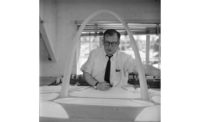The Jefferson National Expansion Memorial in St. Louis, better known as the Gateway Arch, made headlines last month when internal trams carrying roughly 200 people became stalled for several hours after a cable snapped and the power failed. No one was hurt in the incident, which was soon eclipsed by far more serious engineering failures, but it reminded people of the memorial’s unique design by architect Eero Saarinen and structural engineer Hannskarl Bandel.

“It’s such an impressive structure and makes such a statement you would think that it would have been done by a more seasoned architect,” says filmmaker Bob Miano. “What makes it so interesting is that this was Eero Saarinen’s first architectural success on his own.”
Miano, along with co-producer and co-director Scott Huegerich, tell the story of how the arch came together in their documentary The Gateway Arch: A Reflection of America, which airs on public television stations this month. As the filmmakers discovered in interviews with engineers as well as architects including Daniel Libeskind, the structure was ahead of its time when the memorial’s backers selected it in a 1947 competition. The 630-foot-tall arch, composed of triangular sections of stainless steel stacked atop one another, is the product of orthotropic design: the external skin and support system are one and the same.
“Had they had money to start building in the 1940s, they wouldn’t have been able to because the technology didn’t exist for another decade,” Miano observes. “Kudos to the judges who looked at it and said, ‘yeah, this is the one.’”
The arch was eventually completed in 1965. By that point its story was in fact decades in the making—much older, even, than the moment in 1947 when Saarinen bested 170 other entrants in the design competition. It was the Depression-era brainchild of local businessman Luther Ely Smith, who wanted to raise St. Louis’s profile back to what it was in the mid-19th century, when the city was the most important stop for emigrants moving westward.
“Smith dedicated his life to it without having any personal gain at all other than the satisfaction of cleaning up the city and providing jobs to the region,” Huegerich observes. “In the face of countless naysayers, he would not take failure as an option and kept moving toward his ultimate goal. Eero Saarinen is the same: someone who dreamed big.”
The Gateway Arch, which premiered last year in St. Louis, will air tomorrow night in Milwaukee, Wisc., and then in San Diego on Monday. Miano says that other public television stations nationwide have picked up the film and it will continue airing during the next two years.



